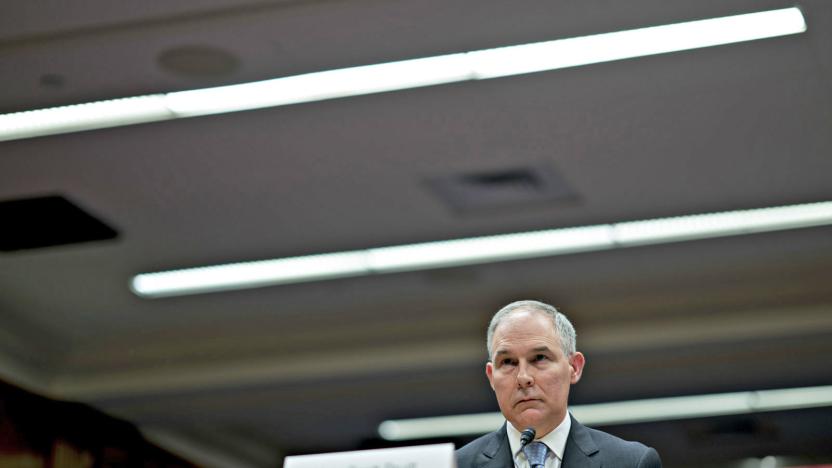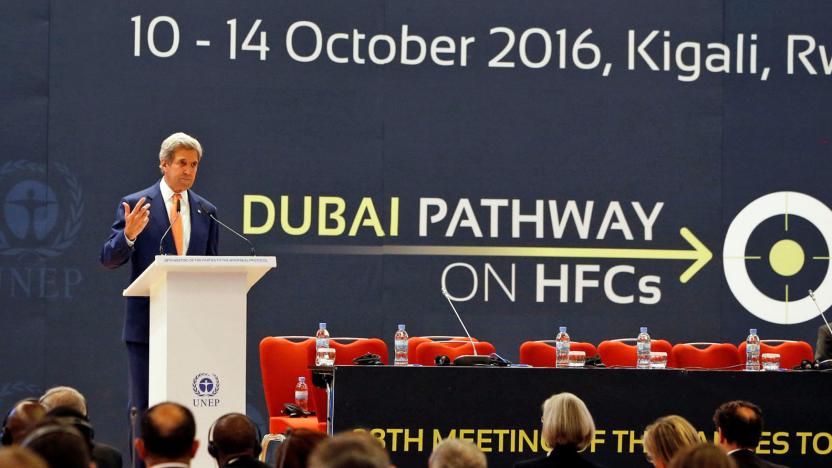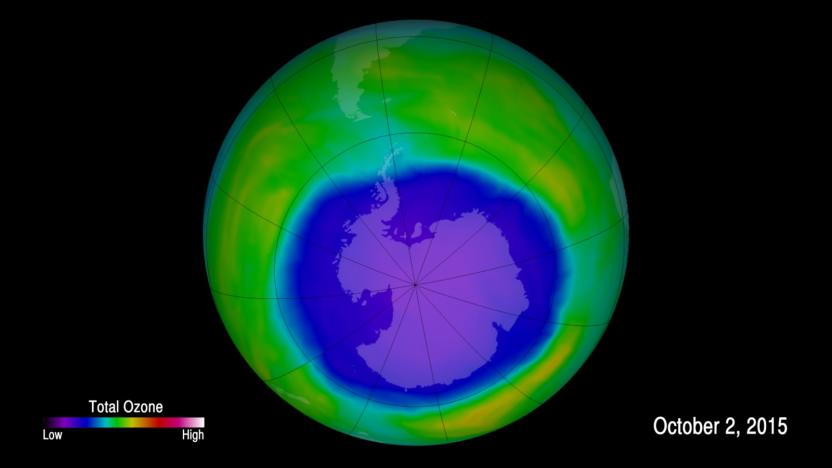ozone
Latest

The UN created a game about protecting the ozone layer
The UN has created a mobile game, 'Reset Earth,' that tasks you with saving the ozone layer.

11 states sue EPA over attempt to reverse ban on ozone-harming HFCs
The Scott Pruitt-era EPA is facing yet more legal action over its attempts at reversing US environmental regulations. A group of 11 states (including New York and California) and the District of Columbia have sued the EPA for violating the Clean Air Act by "effectively" lifting a ban on climate-changing hydrofluorocarbons (HFCs). The states contend that the agency's April "guidance" document illegally removed the entire HFC ban rather than going through the necessary public rulemaking process.

A banned CFC is destroying the ozone and nobody can find its source
Scientists spent years campaigning for a ban on the ozone-damaging chemical CFC-11, but 30 years after it was phased out in the 1987 Montreal Protocol, someone somewhere is breaking the rules. According to the National Oceanic and Atmospheric Administration, emissions of the banned chemical are on the rise, climbing 25 percent since 2012. By now, production of CFC-11 is supposed to be at or near zero.

Treaty ending use of planet-warming HFCs takes effect in 2019
The treaty phasing out the use of Earth-warming hydrofluorocarbons now has an official start date. Sweden has become the 20th country to ratify the Kigali Amendment, invoking a clause that has the measure taking effect on January 1st, 2019. From then on, wealthier countries (less fortunate nations have until 2024 or 2028) must cut back on use of the greenhouse gas in everything from air conditioning to refrigerators. Ideally, this pushes companies to use and develop eco-friendly coolants.

Kigali Amendment reached to cut use of planet-warming HFCs
Today, more than 170 nations have settled on a plan to cut the use of hydrofluorocarbons (or HFCs), a refrigerant that causes warming in the Earth's atmosphere. Called the Kigali Amendment for the location of negotiations in Rwanda, it's the result of seven years of work to expand the Montreal Protocol reached in 1987. That deal phased out the use of ozone-depleting chemicals, and by adding to it, this agreement carries its legally binding weight as a treaty, without needing to wait for ratification like last year's Paris Agreement.

Earth's ozone is on the path to recovery
Good news from the stratosphere: the Earth's ozone layer is healing, the New York Times reports. While researchers have been watching the ozone's comeback for years now, a new study in the journal Science claims the 1987 worldwide ban on chlorofluorocarbons is actually working.

uHoo edges out other air quality monitors with extra sensors
We've now gotten to the point where we can rely on pigeons for monitoring outdoor air quality, and there are plenty of conventional options for indoor as well. But there's always room for improvement, which is why we're looking at the uHoo. Impressively, this pint glass-sized device packs up to five air pollutant sensors, thus allowing it to measure the usual dust and volatile organic compounds, as well as carbon dioxide, carbon monoxide and ozone -- these three can't be detected by most other monitors in the consumer market. On top of that, the uHoo can also keep an eye on the temperature, humidity and air pressure, which comes in handy as these contribute to our wellness, too. The live data is fed to your iOS or Android device via Wi-Fi, and the app will alert you when the air goes bad in one of the rooms.

Earth's ozone improves while CO2 levels worsen
Good news: the hole in the ozone layer is shrinking. Bad news: worldwide levels of atmospheric carbon dioxide has reached another terrifying milestone. First up, NASA's Goddard Space Center is promoting a scientific paper from December that claims that Earth's ozone layer is gently beginning to repair itself. With data from the agency's AURA satellite, scientists believe that the hole in the ozone, which currently measures 12 million square miles, will drop below that figure by around 2040.

Hybrid rocket / seaweed jet ready to fly in 2050, keep emissions above ozone (video)
What's cooler than jetting from Paris to Tokyo in under three hours? Getting there in a biofuel burning hybrid rocketplane. The recently announced superjet, the Zehst (short for "Zero Emission Hypersonic Transportation"), loopholes around the whole pollution angle by only using its rocket engines in the stratosphere. Below the ozone however, seaweed-biofuel powered jet engines will kick in for some keen, green landings. Don't get too excited though, the EADS won't even have a prototype ready until 2020, and commercial flights aren't expected to follow until the hump of the century. Look on the bright side though, you've still got that airline-approved Galaxy Tab to keep you occupied for the next four decades of long, dark, redeyes. That's almost as cool, right?

Verizon's HTC Ozone, Touch Pro2 blessed with official Windows Mobile 6.5 updates
Remember that leaked Ozone ROM from a couple weeks back? Yeah, well, it's back -- and this time it's being offered in a very official way. PCD -- the middleman between Verizon and HTC -- is offering Windows Mobile 6.5-imbued builds for both the Ozone as well as the Touch Pro2, bringing it up to spec with AT&T's Tilt2 which launched with 6.5 out of the gate (thanks in no small part to its late availability). Both updates are posted on PCD's site, so go grab 'em while the grabbing's good. [Thanks, Brian]

Official WinMo 6.5 upgrade for HTC Ozone leaked
Upgrading a Windows Mobile 6.1 Standard device to 6.5 is like putting a fresh coat of paint on your rusted-out '78 Duster, but in the scheme of things, a 6.5 upgrade is still far, far better than a punch in the face. On that note, we're excited to hear that an official update is in the works for Verizon's Ozone from HTC, the CDMA remix of the Snap that launched with 6.1 mere months before 6.5 became widely available. Actually, it's more than "in the works" -- it's available right this very second, just not through any official channels. As usual, it's xda-developers coming through with a copy of the update, so apply it at your own risk; in reality, 6.5 brings very little to the table for Standard handsets, so you shouldn't feel too bad if you wuss out and wait for Verizon to give you the blessed version. Just don't be surprised if you end up waiting half a year for it.

HTC Ozone comes to Verizon June 29 for under $50
Is it cooler than Sprint's Snap? That's for you to judge, but whatever the case, Verizon has now announced its own version of HTC's latest WinMo Standard handset. The so-called Ozone features WiFi, global roaming capability, VZ Navigator and visual voicemail support, a QWERTY keyboard (which feels great if it's anything like its cousin's), and a beefy 1500mAh battery that we're betting will keep this thing going all day and then some. The best part, though, might be the price: it'll be just $49.99 on contract after rebate when it launches online on June 29 and in stores on July 13.

Air purifiers under fire for ozone emission
Normally we're supposed to be concerned about depleting ozone levels to the point where we inhabit one big sauna, but according to an investigative piece by the Wall Street Journal (subscription required), household air purifiers which produce the gas as a byproduct may also pose a significant threat. Studies cited by the Journal suggest that both ozone generation as well as filtration models can emit dangerous levels of the reactive gas, which can be harmful either when inhaled directly or when combined with other common chemicals. While the CSPC is currently studying hard emissions caps to place on these products, California has already taken a first step by limiting purifier ozone output to 50 parts-per-billion starting in 2010. Meanwhile, executives from mall mainstay The Sharper Image are scrambling to discover another gimmicky product they can hang their hats on.

Update: some air purifiers create -- cough, cough -- smog
It's been a year since we first heard that ionic air purifiers can actually make air quality worse, and that finding has now been confirmed by a peer-reviewed, government-funded study. According to the study, which appears in the Journal of the Air & Waste Management Association, using an ionic ozonolysis air purifier in a sealed room can lead to ozone levels as high as 350 parts per billion, a level equivalent to a Los Angeles Stage 2 Smog Alert. The EPA has already come out against ozone-producing air purifiers, saying that they have "little potential to remove indoor air contaminants."Update: As pointed out below in comments, the study quoted above apparently referred to both ionic air purifiers and ozone generators. However, many media outlets, including LiveScience (our source for this post), conflated the two. According to lead researcher Sergey Nizkorodov, a chemistry professor the University of California, Irvine, "ionic air purifiers do emit ozone. [But] none of the ionic air purifiers produce enough ozone when they are used properly to exceed smog alerts." LiveScience has since added a correction, which can be viewed here.





